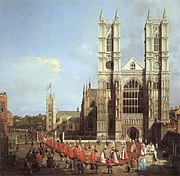| Part of a series on the |
| History of the Church of England |
|---|
 |
The Convocations of Canterbury and York are the synodical assemblies of the bishops and clergy of each of the two provinces which comprise the Church of England. Their origins go back to the ecclesiastical reorganisation carried out under Archbishop Theodore of Canterbury (668–690) and the establishment of a separate northern province in 733. Until 1225 the synods were composed entirely of bishops, but during the thirteenth century more and more clergy were cited until by 1283 the membership was established as the bishops, deans, archdeacons and abbots of each province together with one proctor (representative) from each cathedral chapter and two proctors elected by the clergy of each diocese. The main purpose of the convocations was to take counsel for the well-being of the church and to approve canonical legislation, but in practice much time was spent in discussing the amount of tax to be paid to the Crown since the clergy were a separate estate of the realm and refused to be taxed in or through Parliament. Before the end of the nineteenth century, the Convocation of Canterbury, which was numerically very much larger, played the major role and the activity of the Convocation of York was often little more than giving formal approval to the decisions taken by the southern province.
In 1534 the convocations were subjected to the control of the Crown since they were a focus of resistance to Henry VIII's policies at the time of the Reformation and they continued to function in a restricted way under the supervision of the Crown. In 1603/4 they approved the updating and consolidation into one text of much of the Canon law of the Church of England and in 1661 after the restoration of Charles II they approved the text of the revised Book of Common Prayer before it was submitted to Parliament. Four years later, Archbishop Sheldon agreed to surrender the right of the clergy to tax themselves and as a result the convocations ceased to be licensed for business on a regular basis. Between 1688 and 1717 political tensions ran high between the lower houses which were predominately high church in theology and often Jacobite politically and the bishops who were mainly Whigs and latitudinarians and after 1717 their meetings were limited to the formal sessions required at the beginning of a new parliament.
Pressure for the reactivation of the convocations began to mount in the 1840s as people began to realise that the Church of England and the state were no longer coterminous and that the Church of England needed to find some means of expressing its mind and will; Henry Phillpotts, Bishop of Exeter, was a leading figure in pressing for their revival. In 1852 the Lower House of Canterbury acted on its own initiative and held a proper debate and from then on, despite strong opposition,[clarification needed] many doubts and much debate, both houses of Canterbury gradually increased the range of their activities.[1] York followed suit in 1861 after the death of Archbishop Thomas Musgrave.
In 1919 the two convocations approved a constitution for the proposed National Assembly of the Church of England in which the laity of each province would have full participation along with the four houses of the convocations themselves. They also petitioned Parliament that the new assembly might have the right to transmit legal measures to Parliament where they would either be approved as they stood and then receive the royal assent (and so become part of the law of the land) or be rejected. This was granted at the end of the same year. The convocations lost none of their rights and the assembly could neither issue doctrinal statements nor purport to define the doctrine of the Church of England. However, by the Synodical Government Measure 1969[2] the overlapping functions of the assembly and the convocations were virtually eliminated by the establishment of the General Synod of the Church of England to which almost all their functions and powers were transferred. The convocations still exist, in part because their approval is required for certain legislative proposals and in part because the House of Bishops and the House of Clergy of the General Synod are constituted by the members of the corresponding houses of the convocations.
- ^ Speech by Lord Redesdale, 16 July 1858 (Lords Hansard vol.151 col.1551)
- ^ Synodical Government Measure 1969